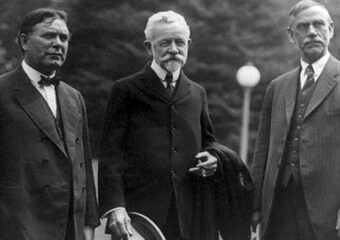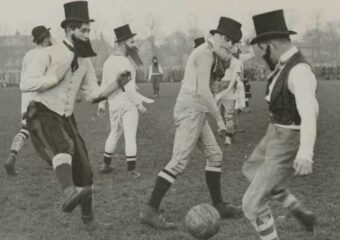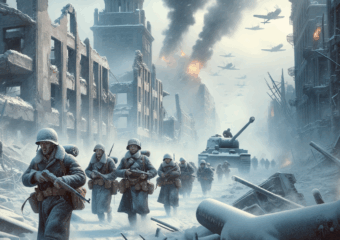In 1916, the historic fortress town of Verdun, standing on the Meuse River was an exposed lightly held outpost of France’s eastern defences.
In the late 19th century, concentric rings of modern forts armoured in steel and concrete had been built around Verdun as part of a defensive line following the Franco-Prussian War of 1870-71. In 1914, the initial fighting came to a halt at trench lines outside the fortified perimeter. Verdun was left surrounded by German-held territory on three sides and supplied along inadequate road and rail links to the rear.
Verdun was a quiet sector of the front. French commander-in-chief General Joseph Joffre resisted pressure to strengthen its trench line, which was recognized as weak. In autumn 1915, believing the fortresses outdated, Joffre stripped the Verdun forts of most of their guns and garrisons to feed his Champagne offensive. In December 1915, Verdun was identified by German Chief of the General Staff General Erich von Falkenhayn as the ideal target for a powerful blow against France.
On 21 February 1916, German forces attacked the French front of Verdun, launching one of the bloodiest battles of the entire war. The success of the initial German offensive was soon turned to stalemate by a stubborn French defence. German Chief of the General Staff General Erich von Falkenhayn viewed the Verdun operation – Germany’s only major offensive on the Western Front between 1914 and 1918 – as an attack on France’s will to fight. French morale would be hit by the loss of Verdun or by the huge losses sustained in defending it. Falkenhayn wrote in a memorandum to Kaiser Wilhelm II on 25 December 1915: “The forces of France will bleed to death… whether we… reach our goal or not.”
The offensive was entrusted to Germany’s Fifth Army, commanded by Crown Prince Wilhelm, but Falkenhayn kept overall control of the battle. Through January and early February 1916, a huge concentration of artillery was built up opposite Verdun, on the east bank of the Meuse.
The German artillery consisted of; 1,200 guns, ranging from giant 420mm howitzers to 77mm field guns, and 2.5 million shells. French aerial reconnaissance over the sector was hampered by German Fighter planes. Nonetheless, hints of the German preparations filtered through to French intelligence. Bad weather forced the Germans to postpone the offensive, originally scheduled for 10 February. This gave the French time to send in two divisions as reinforcements but they were still outnumbered by more than two to one.
The offensive opened on the morning of 21 February with a bombardment lasting 7 hours. The French forward positions were battered relentlessly. To the rear, French artillery batteries were eliminated, and supply links cut. The German infantry attacked in the late afternoon, the specially trained troops using grenades and flamethrowers to neutralize the remaining retractable gun turrets, machine gun bunkers and French troops from their dugouts.
By 23 February French battalions in the forward defences were reduced to a half of a third of their initial strength and were running out of ammunition and food. The Germans pressed forward through the outer trench zone towards the forts around Verdun.
On 25 February, Fort Douaumont, the largest fort was taken by the 24th Brandenburg Regiment.
Before the German offensive, General Joseph Joffre had viewed Verdun as indefensible. Military logic dictated that, if attacked in strength, French troops should withdraw to the west of the Meuse. Politically, however, this was impossible. One of the dead in the early stages of the fighting was Colonel Émile Driant, a politician and writer as well as an army officer, who had vigorously criticized Joffre’s neglect of the defences at Verdun. He was now a martyr whose heroic death could be laid at Joffre’s door. If Verdun fell, Joffre would be blamed.
Wishing to avert this, Joffre sent his deputy, General Noel de Castelnau, to assess the situation. Castelnau duly decided that Verdun must be held at all costs.
On 25 February, the day on which Fort Douaumont fell, General Philippe Pétain took command of the forces at Verdun. As someone who didn’t subscribe to the widespread French belief in the inherent superiority of attack over defence, he turned out to be the ideal person to lead the defence. Pétain’s first step was to cancel the costly infantry counterattacks and focus on artillery as the means to stop the German advance. Guns on the west bank of the Meuse, still in French hands, were used to batter the Germans on the east bank.
The issue of supply was vigorously addressed. As French forces built up – soon half a million French soldiers and 200,000 horses were in the salient.
A road was made to carry the supplies they needed to keep them fighting. It was known as La Voie Sacrée – the sacred way. Afraid that the soldiers’ morale would crack under the strain of the Verdun battlefield, with its unprecedented density of shelling, Pétain instituted strict troop rotation. In principle, no soldier was to spend more than eight days at the front. By early March, Pétain had restored morale and the stubborn French “Poilus” brought the Germans to a halt. Falkenhayn released reserves for an attack on the west bank of the Meuse, but again the French held out, defending the ridge between their positions at Côte 304 and Le Mort Homme. Verdun had been saved but the battle went on.
In the second instalment of the Battle of Verdun: ‘The French Fight Back at Verdun’.
References
- Brown, M. (1999). Verdun 1916. Stroud: Tempus. ISBN 0-7524-1774-6.
- Holstein, C. (2009). Walking Verdun. Barnsley: Pen and Sword. ISBN 978-1-84415-867-6.
- Keegan, J. (1998). The First World War. London: Hutchinson. ISBN 0-09180-178-8.
- MacKenzie, D. A. (1920). The Story of the Great War. Glasgow: Blackie & Son. OCLC 179279677.
- McDannald, A. H. (1920). The Encyclopedia Americana 38. New York: J. B. Lyon. OCLC 506108219.
- Martin, W. (2001). Verdun 1916. London: Osprey. ISBN 1-85532-993-X.
- Mosier, J. (2001). The Myth of the Great War. London: Profile Books. ISBN 1-86197-276-8.
- Pétain, H. P. (1930) [1929]. Verdun. London: Elkin Mathews & Marrot. OCLC 1890922.
- Romains, J. (1938). Prélude à Verdun and Verdun [Verdun] (in French) (Prion Lost Treasures 1999 ed.). Paris: Flammarion. ISBN 1-85375-358-0.
- Rouquerol, J. J. (1931). Le Drame de Douaumont (in French). Paris: Payot. OCLC 248000026.
- Sandler, S. (ed.) (2002). Ground Warfare: an International Encyclopedia I (2002 ed.). Santa Barbara, CA: ABC-CLIO. ISBN 1-57607-344-0.
- Serrigny, B. (1959). Trente Ans avec Pétain (in French). Paris: Librairie Plon. OCLC 469408701.
- Zweig, A. (1936) [1935]. Erziehung vor Verdun [Education before Verdun] (in German) (Viking Press ed.). Amsterdam: Querido Verlag N.V. OCLC 829150704.



